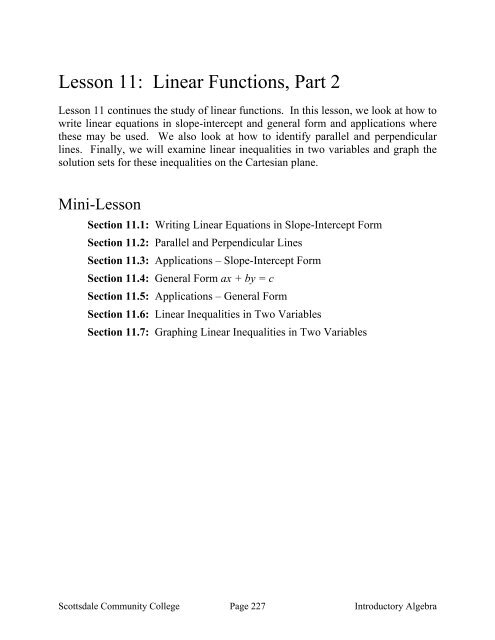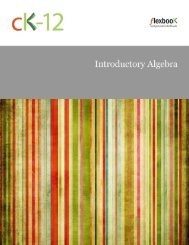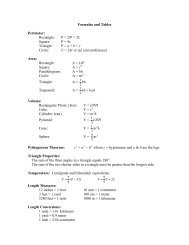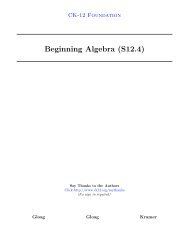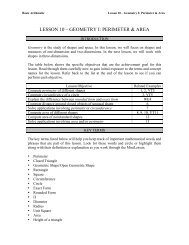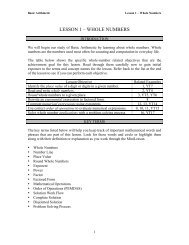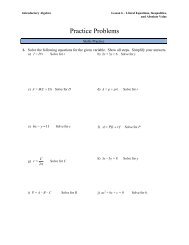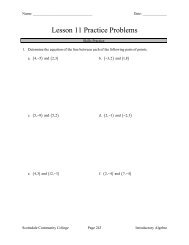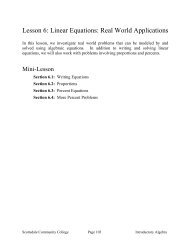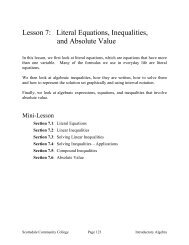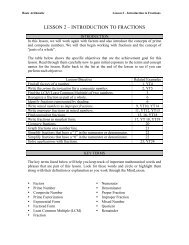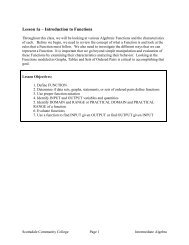Lesson 11: Linear Functions, Part 2 - Scottsdale Community College ...
Lesson 11: Linear Functions, Part 2 - Scottsdale Community College ...
Lesson 11: Linear Functions, Part 2 - Scottsdale Community College ...
Create successful ePaper yourself
Turn your PDF publications into a flip-book with our unique Google optimized e-Paper software.
<strong>Lesson</strong> <strong>11</strong>: <strong>Linear</strong> <strong>Functions</strong>, <strong>Part</strong> 2<br />
<strong>Lesson</strong> <strong>11</strong> continues the study of linear functions. In this lesson, we look at how to<br />
write linear equations in slope-intercept and general form and applications where<br />
these may be used. We also look at how to identify parallel and perpendicular<br />
lines. Finally, we will examine linear inequalities in two variables and graph the<br />
solution sets for these inequalities on the Cartesian plane.<br />
Mini-<strong>Lesson</strong><br />
Section <strong>11</strong>.1: Writing <strong>Linear</strong> Equations in Slope-Intercept Form<br />
Section <strong>11</strong>.2: Parallel and Perpendicular Lines<br />
Section <strong>11</strong>.3: Applications – Slope-Intercept Form<br />
Section <strong>11</strong>.4: General Form ax + by = c<br />
Section <strong>11</strong>.5: Applications – General Form<br />
Section <strong>11</strong>.6: <strong>Linear</strong> Inequalities in Two Variables<br />
Section <strong>11</strong>.7: Graphing <strong>Linear</strong> Inequalities in Two Variables<br />
<strong>Scottsdale</strong> <strong>Community</strong> <strong>College</strong> Page 227 Introductory Algebra
<strong>Lesson</strong> <strong>11</strong> Checklist<br />
Component<br />
Required<br />
Y or N<br />
Comments Due Score<br />
Mini-<strong>Lesson</strong><br />
Online<br />
Homework<br />
Online<br />
Quiz<br />
Online<br />
Test<br />
Practice<br />
Problems<br />
<strong>Lesson</strong><br />
Assessment<br />
<strong>Scottsdale</strong> <strong>Community</strong> <strong>College</strong> Page 228 Introductory Algebra
Name: ________________________________<br />
Date: _____________<br />
Mini-<strong>Lesson</strong> <strong>11</strong> <br />
Section <strong>11</strong>.1: Writing the Equation of a Line<br />
in Slope-Intercept Form<br />
Slope-Intercept Form y = mx + b<br />
Example 1: Give the equation of the line in slope-intercept form<br />
a. With y-intercept (0, 2) and slope !9<br />
b. Passing through (2, 3) with slope !5<br />
c. Passing through (2, 6) and (4, 16)<br />
Example 2: Give the equation of the linear function that would generate the following table<br />
of values. Use your calculator to check.<br />
x f (x)<br />
!5 238<br />
!3 174<br />
!1 <strong>11</strong>0<br />
1 46<br />
7 !146<br />
12 !306<br />
<strong>Scottsdale</strong> <strong>Community</strong> <strong>College</strong> Page 229 Introductory Algebra
<strong>Lesson</strong> <strong>11</strong>: <strong>Linear</strong> <strong>Functions</strong>, <strong>Part</strong> 2<br />
Mini-<strong>Lesson</strong><br />
Example 3: Give the equation of the linear function shown below.<br />
Example 4: Give the equation of the horizontal line passing through the point (1,3).<br />
Example 5: Give the equation of the vertical line passing through the point (1,3).<br />
You Try<br />
1. Give the equation of the line passing through the points ( 1, 7) and ( 3,!9 ) .<br />
2. Give the equation of the horizontal line passing through the point (5, <strong>11</strong>).<br />
<strong>Scottsdale</strong> <strong>Community</strong> <strong>College</strong> Page 230 Introductory Algebra
<strong>Lesson</strong> <strong>11</strong>: <strong>Linear</strong> <strong>Functions</strong>, <strong>Part</strong> 2<br />
Mini-<strong>Lesson</strong><br />
Section <strong>11</strong>.2: Parallel and Perpendicular Lines<br />
Parallel Lines<br />
The slopes of Parallel Lines are ______________________________________________<br />
Example 1: Give the equation of the line passing through the point (8, 3) that is parallel to<br />
the line y = –2x + 3.<br />
Perpendicular Lines<br />
The slopes of perpendicular lines are __________________________________________<br />
If Line 1 and Line 2 are perpendicular to each other, then<br />
Slope of line 1 Slope of line 2<br />
2<br />
3<br />
5<br />
–8<br />
! 4 5<br />
Example 2: Give the equation of the line passing through the point (8, 3) that is<br />
perpendicular to the line y = –2x + 3.<br />
<strong>Scottsdale</strong> <strong>Community</strong> <strong>College</strong> Page 231 Introductory Algebra
<strong>Lesson</strong> <strong>11</strong>: <strong>Linear</strong> <strong>Functions</strong>, <strong>Part</strong> 2<br />
Mini-<strong>Lesson</strong><br />
You Try<br />
3. Give the equation of the line passing through the point (–3, 1) that is parallel to the line<br />
y = 8x – 5 .<br />
4. Give the equation of the line passing through the point (–3, 1) that is perpendicular to the<br />
line y = 8x – 5 .<br />
<strong>Scottsdale</strong> <strong>Community</strong> <strong>College</strong> Page 232 Introductory Algebra
<strong>Lesson</strong> <strong>11</strong>: <strong>Linear</strong> <strong>Functions</strong>, <strong>Part</strong> 2<br />
Mini-<strong>Lesson</strong><br />
Section <strong>11</strong>.3: Applications – Slope-Intercept Form<br />
Example 1: You have just bought a new Sony 55” 3D television set for $2300. The TV’s value<br />
decreases at a rate of $250 per year. Construct a linear function to represent this situation.<br />
Example 2: In 1998, the cost of tuition at a large Midwestern university was $144 per credit<br />
hour. In 2008, tuition had risen to $238 per credit hour. Determine a linear equation to represent<br />
the cost, C, of tuition as a function of x, the number of years since 1990.<br />
<strong>Scottsdale</strong> <strong>Community</strong> <strong>College</strong> Page 233 Introductory Algebra
<strong>Lesson</strong> <strong>11</strong>: <strong>Linear</strong> <strong>Functions</strong>, <strong>Part</strong> 2<br />
Mini-<strong>Lesson</strong><br />
You Try<br />
5. A new Chevrolet Corvette costs $56,980. The car’s value depreciates to $31,870 after four<br />
years.<br />
a. Determine a linear equation to represent this situation. Clearly indicate what each<br />
variable represents.<br />
b. Identify the slope and explain its meaning.<br />
c. Identify the vertical intercept, and explain its meaning.<br />
d. Determine the horizontal intercept, and explain its meaning.<br />
<strong>Scottsdale</strong> <strong>Community</strong> <strong>College</strong> Page 234 Introductory Algebra
<strong>Lesson</strong> <strong>11</strong>: <strong>Linear</strong> <strong>Functions</strong>, <strong>Part</strong> 2<br />
Mini-<strong>Lesson</strong><br />
Section <strong>11</strong>.4: General Form: ax + by = c<br />
Example 1: Consider the linear equation 3x – 5y = 30.<br />
a. Write this equation in slope-intercept form.<br />
b. Identify the slope.<br />
c. Determine the vertical intercept.<br />
d. Determine the horizontal intercept.<br />
<strong>Scottsdale</strong> <strong>Community</strong> <strong>College</strong> Page 235 Introductory Algebra
<strong>Lesson</strong> <strong>11</strong>: <strong>Linear</strong> <strong>Functions</strong>, <strong>Part</strong> 2<br />
Mini-<strong>Lesson</strong><br />
Example 2: Draw an accurate graph of the function 3x + 2y = 16.<br />
Slope-Intercept Form:<br />
_______________________<br />
Slope: ___________<br />
Vertical Intercept: ___________<br />
Horizontal Intercept: _________<br />
Two additional points on the line:<br />
___________ __________<br />
You Try<br />
6. Draw an accurate graph of the function 4x – y = 7<br />
Slope-Intercept Form:<br />
_______________________<br />
Slope: ___________<br />
Vertical Intercept: __________<br />
Horizontal Intercept: ________<br />
Two additional points line:<br />
___________<br />
____________<br />
<strong>Scottsdale</strong> <strong>Community</strong> <strong>College</strong> Page 236 Introductory Algebra
<strong>Lesson</strong> <strong>11</strong>: <strong>Linear</strong> <strong>Functions</strong>, <strong>Part</strong> 2<br />
Mini-<strong>Lesson</strong><br />
Section <strong>11</strong>.5: Applications – General Form<br />
Example 1: Movie tickets cost $7 for adults (matinee), $5.50 for children. A total of $668<br />
was collected in ticket sales for the Saturday matinee.<br />
a. Write an equation representing the total amount of money collected.<br />
b. If 42 adult tickets were purchased for this matinee, how many children were there<br />
You Try<br />
7. Tickets to a 3D movie cost $12.50 for adults and $8.50 for children. A total of $932 was<br />
collected in ticket sales for the 7:15PM show.<br />
a. Write an equation representing the total amount of money collected.<br />
b. If 17 children’s tickets were purchased, how many adults were there<br />
<strong>Scottsdale</strong> <strong>Community</strong> <strong>College</strong> Page 237 Introductory Algebra
<strong>Lesson</strong> <strong>11</strong>: <strong>Linear</strong> <strong>Functions</strong>, <strong>Part</strong> 2<br />
Mini-<strong>Lesson</strong><br />
<strong>Scottsdale</strong> <strong>Community</strong> <strong>College</strong> Page 238 Introductory Algebra
<strong>Lesson</strong> <strong>11</strong>: <strong>Linear</strong> <strong>Functions</strong>, <strong>Part</strong> 2<br />
Mini-<strong>Lesson</strong><br />
Section <strong>11</strong>.6: <strong>Linear</strong> Inequalities in Two Variables<br />
Example 1: Graph the equation y = 2x – 3<br />
The Solution Set<br />
Example 2: Which of the ordered pairs below satisfy the equation y = 2x− 3<br />
(5, 3) (2, 1) (0, 0)<br />
Example 3: Which of the ordered pairs below satisfy the inequality y≤2x− 3<br />
(5, 3) (2, 1) (0, 0)<br />
Example 4: Graph the linear inequality y≤2x− 3.<br />
<strong>Scottsdale</strong> <strong>Community</strong> <strong>College</strong> Page 239 Introductory Algebra
<strong>Lesson</strong> <strong>11</strong>: <strong>Linear</strong> <strong>Functions</strong>, <strong>Part</strong> 2<br />
Mini-<strong>Lesson</strong><br />
Example 5: Which of the ordered pairs below satisfy the inequality y< 2x−<br />
3<br />
(5, 3) (2, 1) (0, 0)<br />
Example 6: Graph the linear inequality y< 2x− 3.<br />
You Try<br />
8. Which of the ordered pairs below satisfy the linear inequality y ! 4 " 2x <br />
(1,2) (0, 0) (5, 0)<br />
9. Which of the ordered pairs below satisfy the linear inequality y < 4 ! 2x <br />
(1,2) (0, 0) (5, 0)<br />
<strong>Scottsdale</strong> <strong>Community</strong> <strong>College</strong> Page 240 Introductory Algebra
<strong>Lesson</strong> <strong>11</strong>: <strong>Linear</strong> <strong>Functions</strong>, <strong>Part</strong> 2<br />
Mini-<strong>Lesson</strong><br />
Section <strong>11</strong>.7: Graphing <strong>Linear</strong> Inequalities in Two<br />
Variables<br />
Graphing The Solution Set of a <strong>Linear</strong> Inequality in Two Variables<br />
Step 1: Rewrite the inequality as an equality statement.<br />
Step 2: Graph the linear equation. This is the boundary of the solution region.<br />
Step 3: Determine if the line should be solid or dotted.<br />
• If the original inequality statement is either < or >, draw a dotted line.<br />
• If the original inequality statement is either ≤ or ≥, draw a solid line.<br />
Step 4: Choose a test point and plug it into the original inequality.<br />
• If the test point satisfies the inequality, shade in the direction of the test point.<br />
• If the test point does not satisfy the inequality, shade in the opposite direction of the<br />
test point.<br />
Example 1: Graph the inequality y < 5 – 3x.<br />
Example 2: Graph the inequality 3x – 2y ≥ 6.<br />
<strong>Scottsdale</strong> <strong>Community</strong> <strong>College</strong> Page 241 Introductory Algebra
<strong>Lesson</strong> <strong>11</strong>: <strong>Linear</strong> <strong>Functions</strong>, <strong>Part</strong> 2<br />
Mini-<strong>Lesson</strong><br />
Example 3: Graph the inequality y ≥ 2x.<br />
10. Graph the inequality y > 2x – 1.<br />
You Try<br />
<strong>Scottsdale</strong> <strong>Community</strong> <strong>College</strong> Page 242 Introductory Algebra


